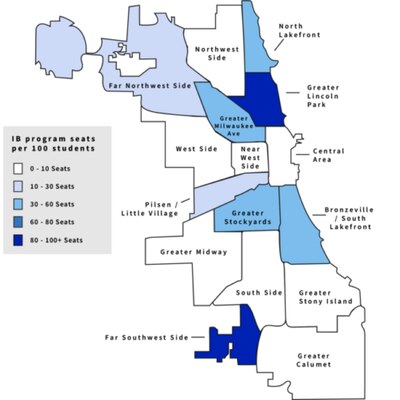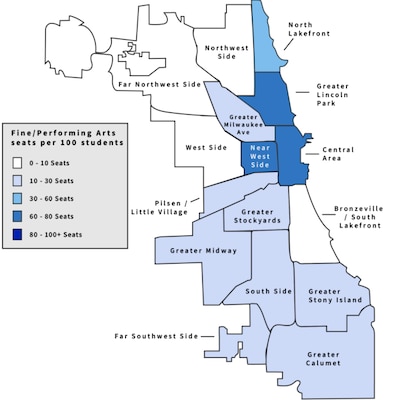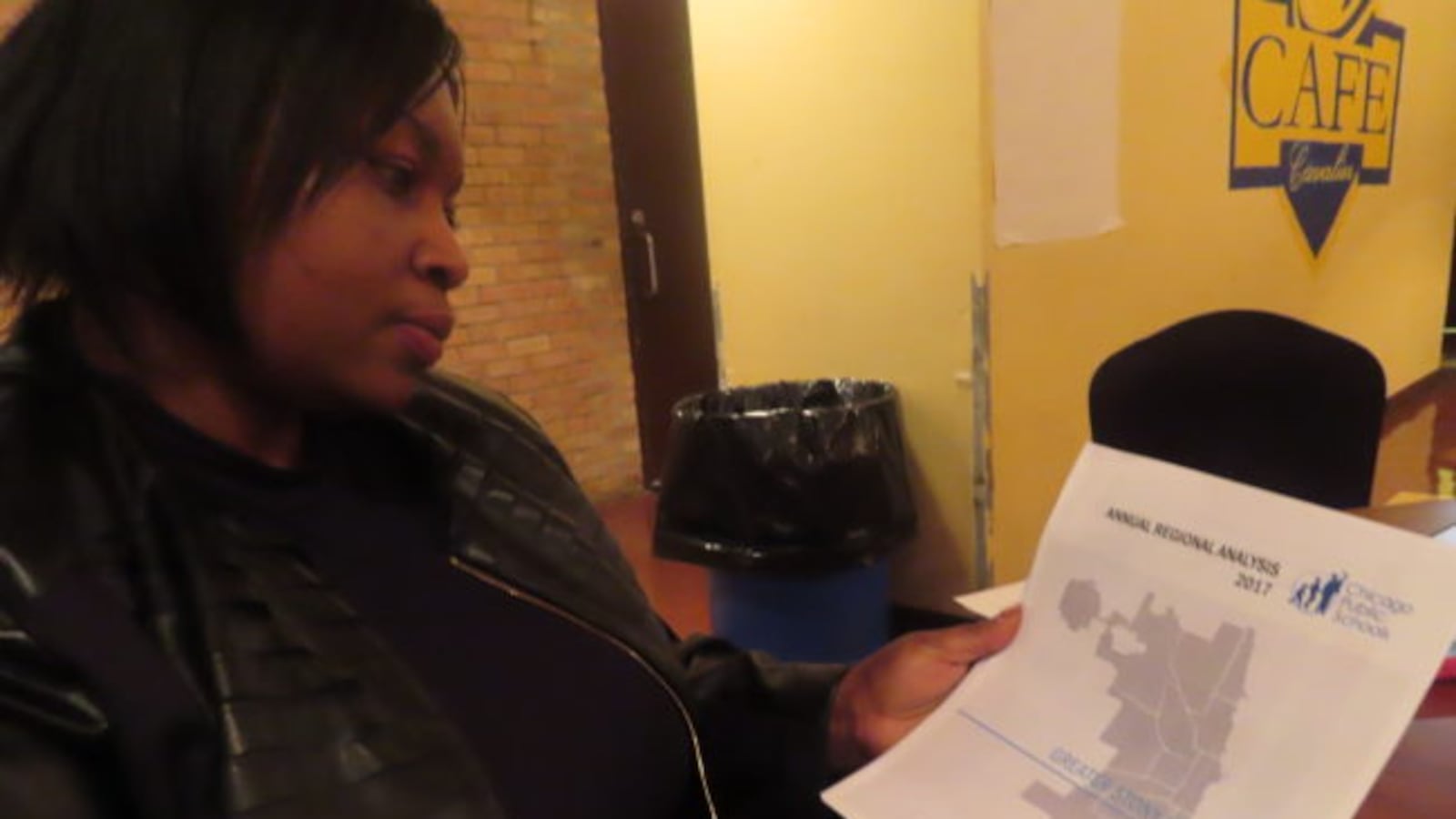Chicago Public Schools will hold six more workshops offering the public a chance to comment on a controversial report about enrollment, academic options and quality at schools throughout Chicago.
The district’s Annual Regional Analysis divides the city into 16 “planning regions,” and shows that in many places, students are skipping out on nearby options, with less than half of district students attending their designated neighborhood schools. The report, which heavily relies on school quality ratings, also shows that top academic schools are often concentrated in wealthier neighborhoods, and that fewer black and Latino students have access to those schools compared with their white and Asian peers.
The district compiled the report with the assistance of the school-choice group Kids First using figures from the 2017-2018 school year.
The meetings will start with a presentation on the report, and include small-group discussions to brainstorm how the district can invest in and strengthen schools.
Chalkbeat Chicago has attended two of the meetings so far. One was held in a predominantly black slice of the Far South Side where residents pushed the district to better engage families and help dispel stigmas they say make their campuses a tough pitch to prospective families. The other was in a mostly Latino swath of the city, where parents called for more resources for neighborhood schools, like counselors and bilingual teachers.
Here’s a list of presentations to come, and a preview of the issues facing communities where the meetings are scheduled:
Greater Midway Region — Dec. 6 — Curie Metropolitan High School, 4959 S. Archer Ave.
The Midway Region, which includes Southwest Side neighborhoods like Ashburn, Chicago Lawn, and Gage Park, has lost far fewer students than most regions in the Chicago. This part of Chicago has been growing while other parts have declined, as Latino families have poured in, older white populations have aged out and black residents, as in most parts of the city, have moved away. The number of district students living in the Greater Midway Region has dropped by about 2 percent since 2014-2015, compared with 6 percent citywide.
The region has a higher than average percentage of students who attend their neighborhood schools. Midway high schools offer many vocational courses, but provide comparatively fewer seats in International Baccalaureate and selective-enrollment program seats compared to the student population.

North Lakefront Region —Dec. 11 — Sullivan High School, 6631 N. Bosworth Ave.
The student population living in the North Lakefront Region is one of the most diverse in the district, 37 percent Latino, 29 percent black, 17 percent white and 12 percent Asian. But the region has grown whiter and wealthier since 2014. The percent of students qualifying for subsidized lunch has dropped from 80 percent to 71 percent since 2014.
But in this diverse community, which includes neighborhoods like Uptown and Rogers Park, stark disparities remain: 63 percent of black students and 74 percent of Latino students attend a Level 1 or Level 1-plus school compared with 88 percent of white students.
Near West Side Region — Dec. 12 —Phoenix Military Academy High School, 145 S. Campbell Ave.
The booming but unequal Near West Side Region includes the glitzy West Loop but also high-poverty neighborhoods like the Tri-Taylor area. It’s the future site of a proposed $70 million high school backed by a pro-business group and a neighborhood organization led by mostly white professionals. The leader of one of the groups told Chalkbeat in an interview earlier this year that many supporters don’t view current neighborhood high schools, like Wells Academy, as acceptable options.
While white people have flocked to the area, especially the affluent West Loop, the black population has plummeted. In 1990, about 66 percent of Near West Side residents were black and 19 percent were white. Nearly 20,000 new residents have moved in since then. Today, the Near West Side is 30 percent black and 42 percent white.
Only 7 percent high school students attend their zoned school — while more than 2,400 top-rated high school seats go unfilled. The Near West’s school-age population has increased, but enrollment in its schools has dropped. Most of its students are black, but they are the least likely to attend top-rated schools.
Bronzeville/South Lakefront Region — Dec. 13 — Dyett High School for the Arts, 555 E. 51st St.
When we talk about disparities at Chicago schools, the conversation usually compares historically underserved areas like the South Side to the majority white North Side. However, a large swath of the south lakefront, including Hyde Park, Kenwood, and Bronzeville shows how school-quality disparities exist even in a region where 92 percent of students are black.
Schools in the north and western parts of the Bronzeville/South Lakefront Region, toward Bronzeville, tend to have the lowest ratings, while schools closer to the lake and Hyde Park tend to have higher ratings.
Bronzeville, a culturally rich neighborhood known as Chicago’s “Black Metropolis,” has lost about half of its black population since 1990. The neighborhood is a short drive from Woodlawn, where the Obama Presidential Center is slated to be built.
The public school population in the region has decreased by 6.7 percent since the 2014-2015 school year. Enrollment in schools in the region is declining at a faster pace, 12.7 percent. Bronzeville elementary schools also have a dearth of fine and performing arts program seats, according to the district report.

Northwest Side Region — Dec. 18 — Roosevelt High School, 3436 W. Wilson Ave.
Like the North Lakefront Region, this is a diverse part of the city’s North Side whose district population has grown whiter and more affluent in recent years. The Northwest Side Region’s student body is 47 percent Hispanic, 24 percent white and 16 percent Asian, while 67 percent qualify for subsidized lunch.
It includes several selective enrollment schools like Chappell Elementary School, Lane Technical High School, and Northside College Preparatory High School.
Among elementary students, 95 percent attend a Level 1 or 1-plus school. In high school, 85 percent of students attend the highest-rated high schools. In the Northwest Side, 42 out of 47 schools are highly rated.
Neighborhoods include community areas like Avondale, Lincoln Square, and Albany Park, where the local high school options offer dramatically different opportunities.
Central Area Region — Dec. 19 — Ray Graham Training Center High School, 2347 S. Wabash Ave.
The Central Area Region‘s student population is about 20 percent white, 30 percent Asian, 34 percent black and 11 percent Hispanic. It’s the only region where white and Asian students outnumber black and Hispanic students. The majority of students attend Level 1 or Level 1-plus schools, although black students are the most likely to attend Level 2 schools.
The area is gaining Asian students and losing black students, and the families are growing more moneyed. Of course, the Central Area includes downtown and the Loop, two of the wealthiest and well-developed parts of the city, and is home to several selective-enrollment schools.
The district population and enrollment have increased since 2014, unlike most parts of Chicago. Only 8 percent of high school students living in the area attend their zoned school, which may have to do with the abundance of competitive, selective-enrollment options, like Jones College Preparatory High School.

